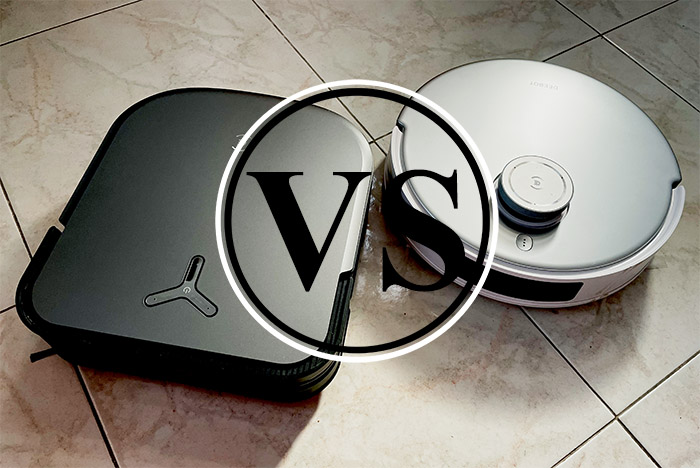The ECOVACS DEEBOT X2 Omni and T20 Omni are the best robot vacuum cleaners that ECOVACS has to offer at the moment, the latter only recently losing its flagship title to the former device. The X2 Omni does take quite a few elements from the T20 Omni, but almost everything has been redesigned and adjusted to perform better or at least that’s what ECOVACS was aiming for.
The cleaning station retains all the functions, but it is a bit smaller (as you will see, the water flow differs between the two robot vacuum cleaners). In terms of shape and looks, the X2 Omni and the T20 Omni are almost completely different, the first going for a narrow rectangular case, while the latter retaining the traditional look.
| ECOVACS DEEBOT X2 Omni | |
|---|---|
| Amazon.com | Check Product |
| ECOVACS DEEBOT T20 Omni | |
|---|---|
| Amazon.com | Check Product |
The navigation systems are also very different, the T20 Omni relying on LiDAR for mapping the house and extra lasers for detecting objects in the rooms. The X2 Omni does use LiDAR, but in a more limited manner, supplementing any shortcomings with the camera-based AIVI 3D 2.0 system. Yes, it’s the same technology that we saw on the X1 Omni, but with some serious updates to make the object detection even better.
The roller brush size is also different between the two robot vacuum cleaners, as well as the number of side brushes, so ECOVACS has worked quite a bit to properly distinguish these two models. What about the software? It’s true that both the X2 Omni and the T20 Omni use the same app, but there are some major differences, as well as some particular behaviors fort each device. So, let’s put the X2 Omni and the T20 Omni side by side and see which is the most suitable for your exigence.
Note: You can also check out the individual analysis of each robot vacuum cleaner: ECOVACS DEEBOT X2 Omni and ECOVACS DEEBOT T20 Omni.
Design and Build Quality
The DEEBOT T20 Omni follows the design of the regular robot vacuum cleaners, so it’s round and fairly big, measuring 14.3 x 14.3 x 4.0 inches. It has the usual top-facing protrusion for the LiDAR moving parts and on the bumper, we can see both the collision sensors and the TrueDetect 3D sensor component for detecting obstacles.
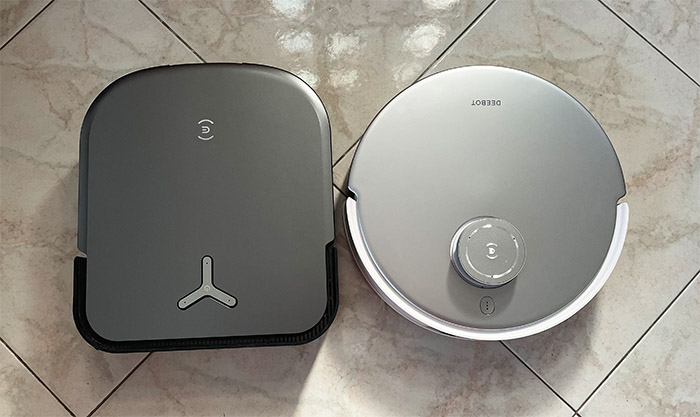
The X2 Omni is a completely different device, moving quite far from the traditional look of robot vacuum cleaners and going for a narrow rectangular shape instead of being round. This should mean that it can better access difficult-to-reach spaces, and indeed it does because it uses solid state LiDAR and AIVI 3D 2.0 for navigation and object collision. The latter is the front-facing camera assembly on the front, while the former covers about half of the bumper.
I did mention LiDAR, but where’s the bump? Since it’s solid state LiDAR, it does not have moving components, so it allowed the X2 Omni to go underneath furniture and beds with ease. It makes you wonder why haven’t the manufacturer thought about going for a different shape (than round) sooner. I won’t deny that this adventurous nature could ensure that the X2 Omni gets stuck more often, but perhaps it’s worth the price (I have watched the X2 Omni trying to get out from underneath a chair for about two minutes and it was glorious after it made it out!).
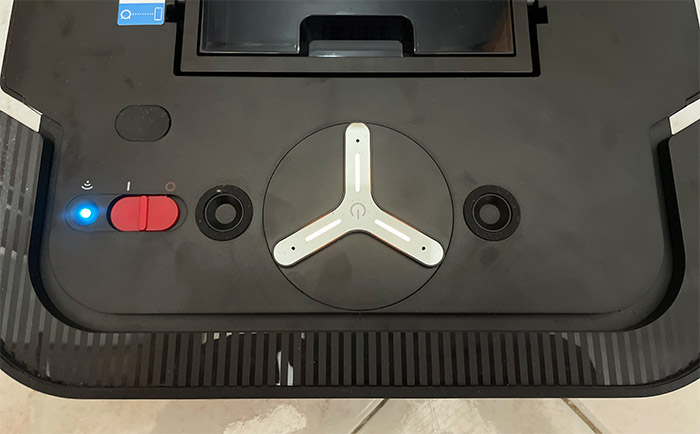
Moving forward, the X2 Omni and the T20 Omni do have in common the lid that’s held magnetically at the top, the buttons and the dust bin (which is roughly the same size on both robot vacuum cleaners).
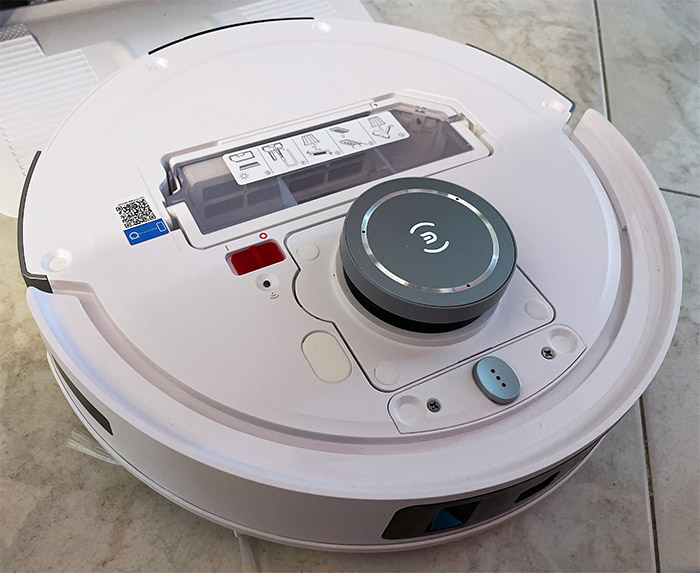
On the bottom, both the X2 Omni and the T20 Omni have cliff sensors and a main rolling brush, but the developers decided it would be better to make it a bit bigger on the X2 Omni. Also, while the T20 Omni has two side brushes, the X2 Omni has only one. I have tested both and I couldn’t really find a significant difference on whether the two-side brushes system is better. Oh, and I need to mention that the main brushes don’t have bristles, but do rely on silicone flaps to capture dirt and dust.
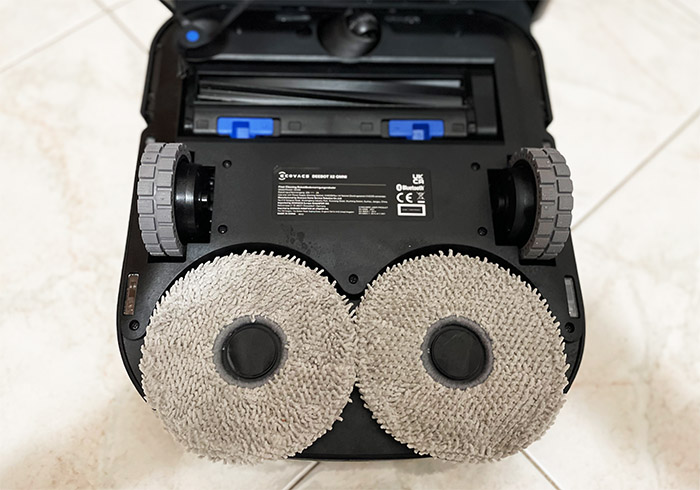
The X2 Omni and the T20 Omni have a built-in voice assistant (called Yiko), so there are some speakers underneath the lid and three microphones on each device to facilitate a two-way communication with the user.
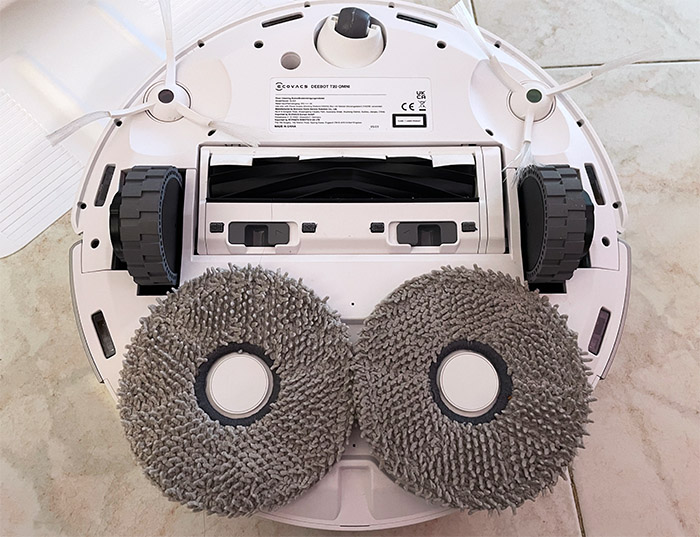
VERDICT: From the looks and design point of view, the X2 Omni and the T20 Omni couldn’t be more different and, considering that the X2 Omni is more versatile, without sacrificing much of its size (as the SwitchBot K10+ did), I think that it easily wins this round.
X2 Omni and T20 Omni Internal Hardware
I won’t go in detail about how to open each robot vacuum cleaner, but do know that they’re as difficult to open as you’d imagine, but not that different from other robot vacuum cleaners. The battery is easily accessible though which is nice and it can be done by removing the first bottom plastic layer.
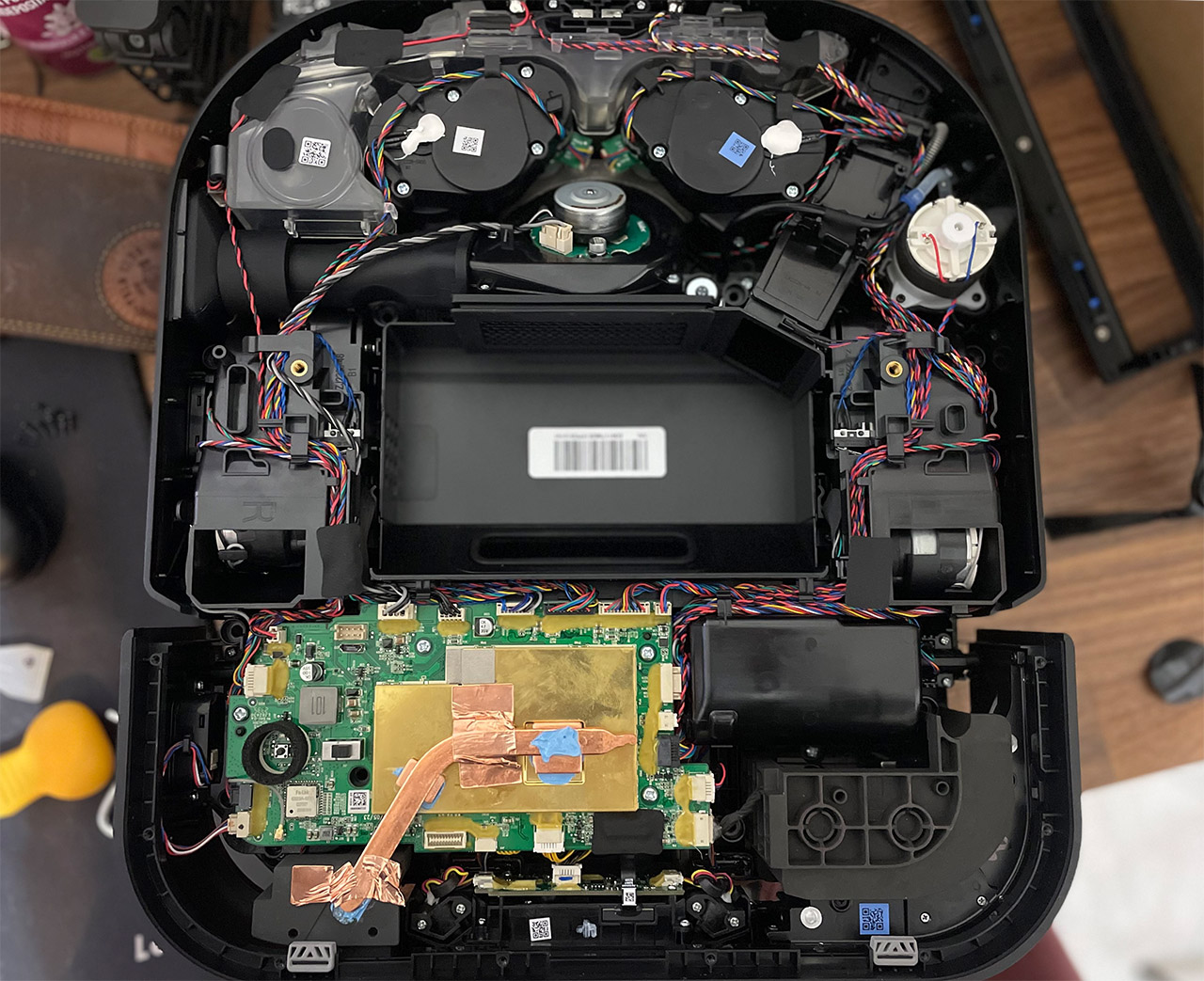
What I did noticed during the teardown of the X2 Omni and the T20 Omni was that the former had metallic bumper plates, while the latter had them made of plastic (not sure if it will make a difference in the long run since neither devices bump into stuff that often). And an important aspect was the internal cooling system which was a bit better on the X2 Omni (copper relays vs a single aluminum plate on the T20 Omni).
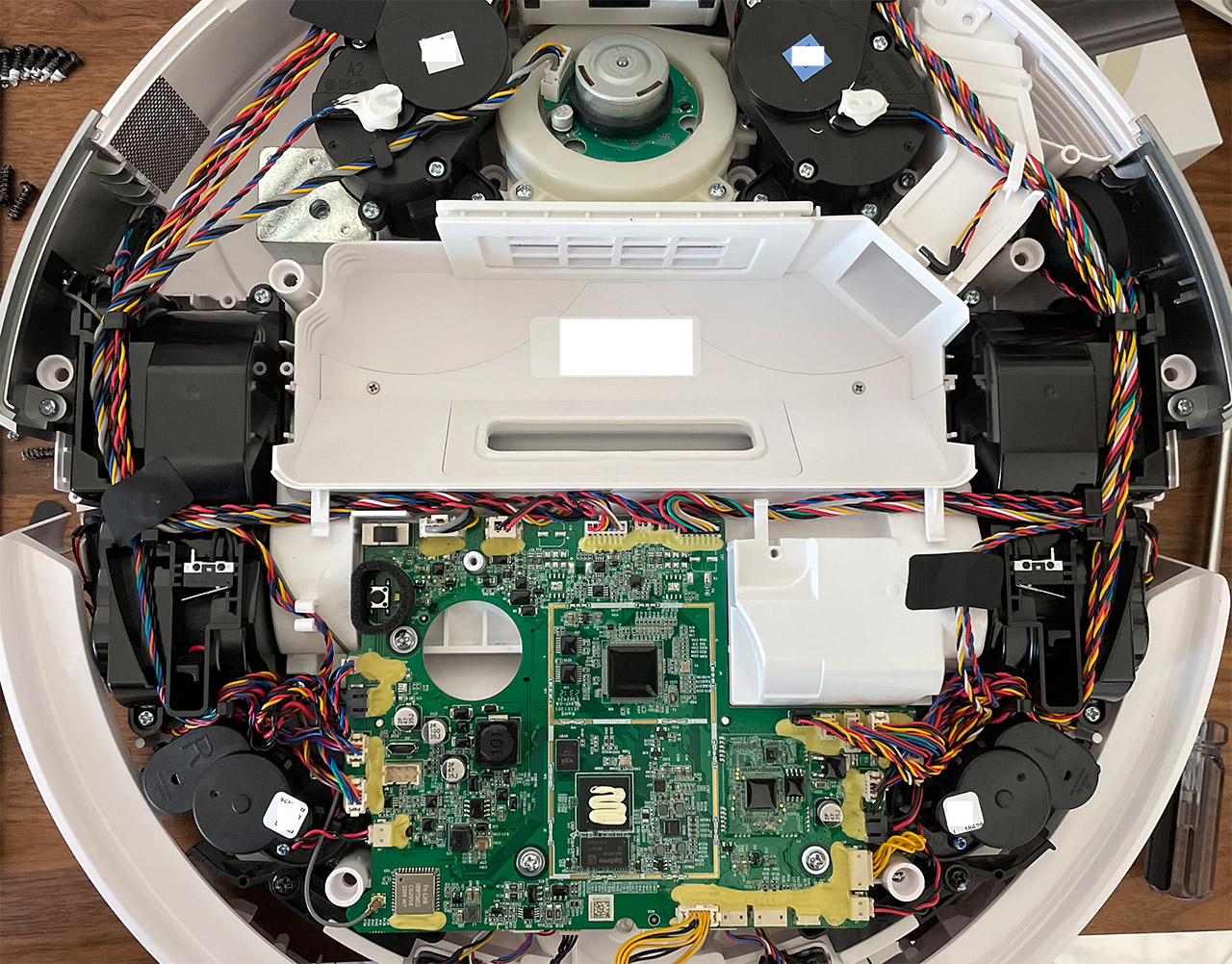
VERDICT: Although both the X2 Omni and the T20 Omni are very similar inside the case, I think that the X2 Omni is a bit better built, so it wins this round.
The Docking Stations
One of the most interesting aspects of the newest ECOVACS robot vacuum cleaners is the accompanying docking stations. Yes, they’re larger than what I was used to but their functions are spectacular. In the case of the DEEBOT X2 Omni and the T20 Omni, the stations will shower the mopping pads with hot water (the advertised temperature is 141F, but I found out it’s a bit less than that) and then they’ll use heat to dry them up.
Additionally, you don’t have to add water into the robot vacuum cleaners themselves, no, you need to insert clean water in the secondary water tank, which will then be transferred towards the X2 Omni or the T2 Omni. Then, after the cleaning of the mopping pads is done, the dirty water is transferred towards the dirty water tank. This means way less maintenance from the part of the user.
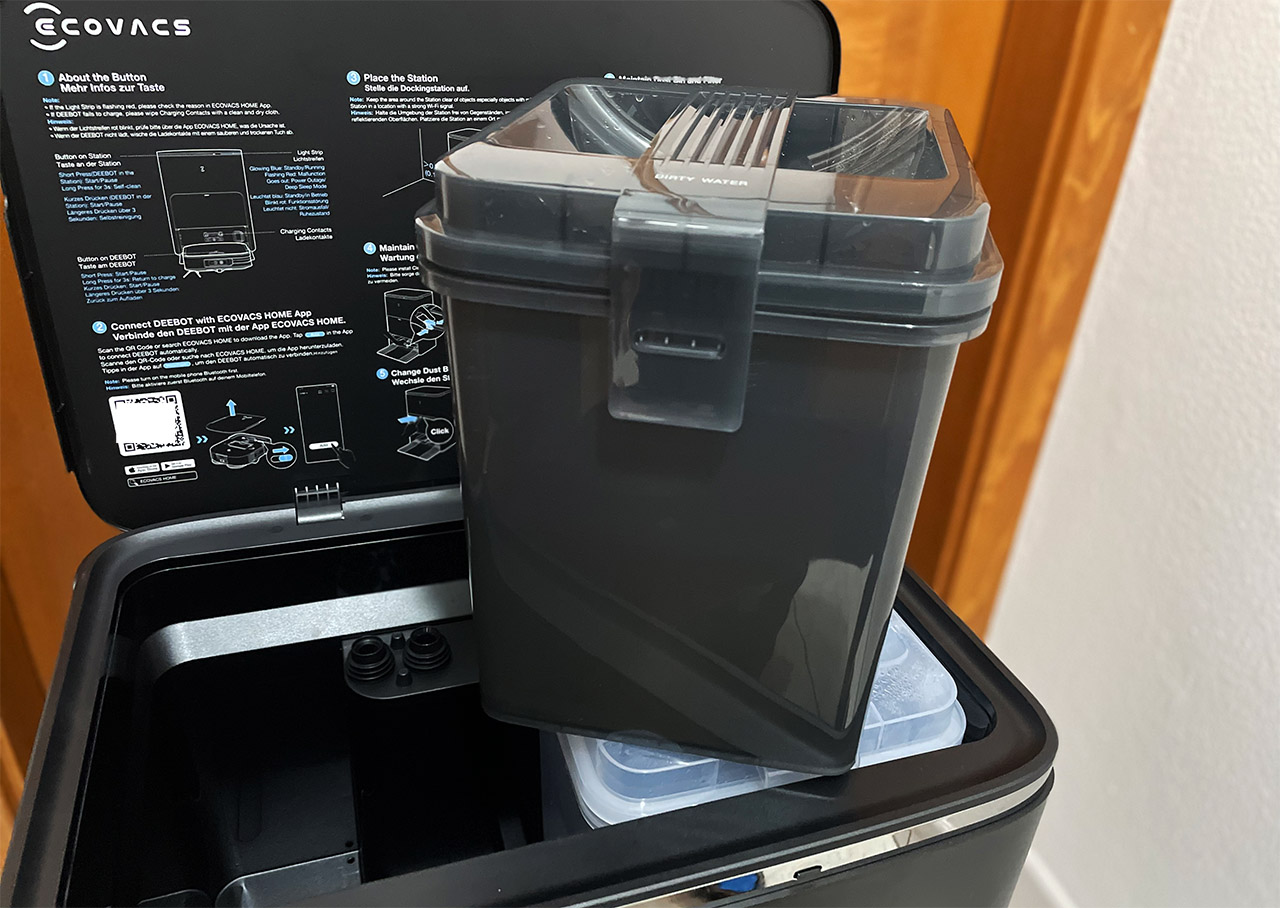
Additionally, both docking stations support 3L universal dust bags. That being said, what’s the difference between the docking stations of the two robot vacuum cleaners. It’s the size. The X2 Omni has a smaller station with smaller water tanks, but that doesn’t mean it underperforms when compared to the T20 Omni.
I noticed when I tested the two devices that the T20 Omni would consume water at a higher rate than the X2 Omni. So, the difference will be in the mopping pads wetness, which, as you will see, doesn’t really help that much in handling dirt spots.
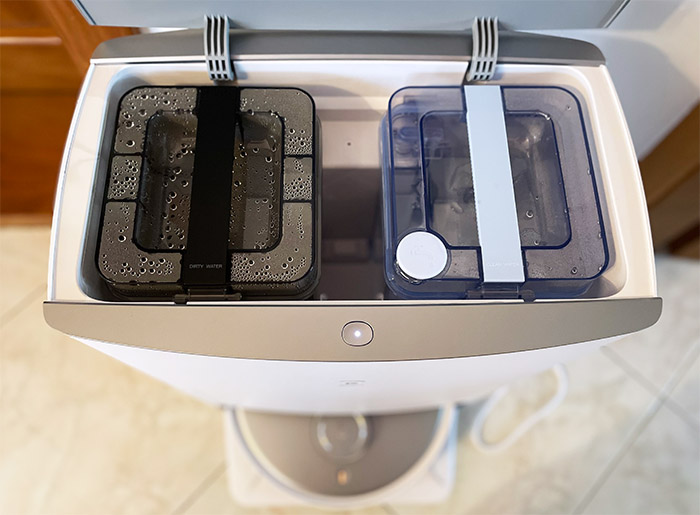
VERDICT: Yes, the X2 Omni has a smaller docking station, but the reduced size of the water tanks doesn’t seem to have a negative impact on the performance, so the two robot vacuum cleaners are pretty much even in this regard.
A story of two mopping pads
The rolling mopping pads is a relatively new addition to the ECOVACS robot vacuum cleaners and I have seen it on the X1 Omni, so it’s obviously a mandatory piece of equipment for the X2 Omni and the T20 Omni. And, while the end result is the same: two rotating mopping pads, there are a few differences in implementation.
The T20 Omni did have a hard time with the initial set of rolling plates because they would often fall off – yes, they were a separate accessory – but it seems that this problems has been corrected because they were very sturdily attached to my DEEBOT T20 Omni. The X2 Omni comes with the rolling plates already attached and to replace them, you will have to make good use of a screwdriver.
The mopping pads are the same on both robot vacuum cleaners and I think that the rotation velocity is roughly the same as well. I have tested this system with both old difficult stains and some ‘more recent’ ones and they are able to do a very good job.
Obviously, it’s not going to be at the level of a professional scrubber, but the end result is very good for a robot vacuum cleaner.
VERDICT: The mopping system is pretty much the same for the X2 Omni and the T2 Omni, and the performance is also roughly the same, so this round ends in a tie.
The Installation
While the hardware installation doesn’t differ between the two devices, I have noticed that pairing the X2 Omni is substantially less annoying when compared to the T20 Omni. The app does require the acceptance of the User Agreement and the Privacy Policy, which show that there is data collection from both the smartphone and the robot vacuum cleaner.
But the ECOVACS DEEBOT T20 Omni wants access to your precise location and wants to detect devices in your local network without giving the option to enter any data manually.
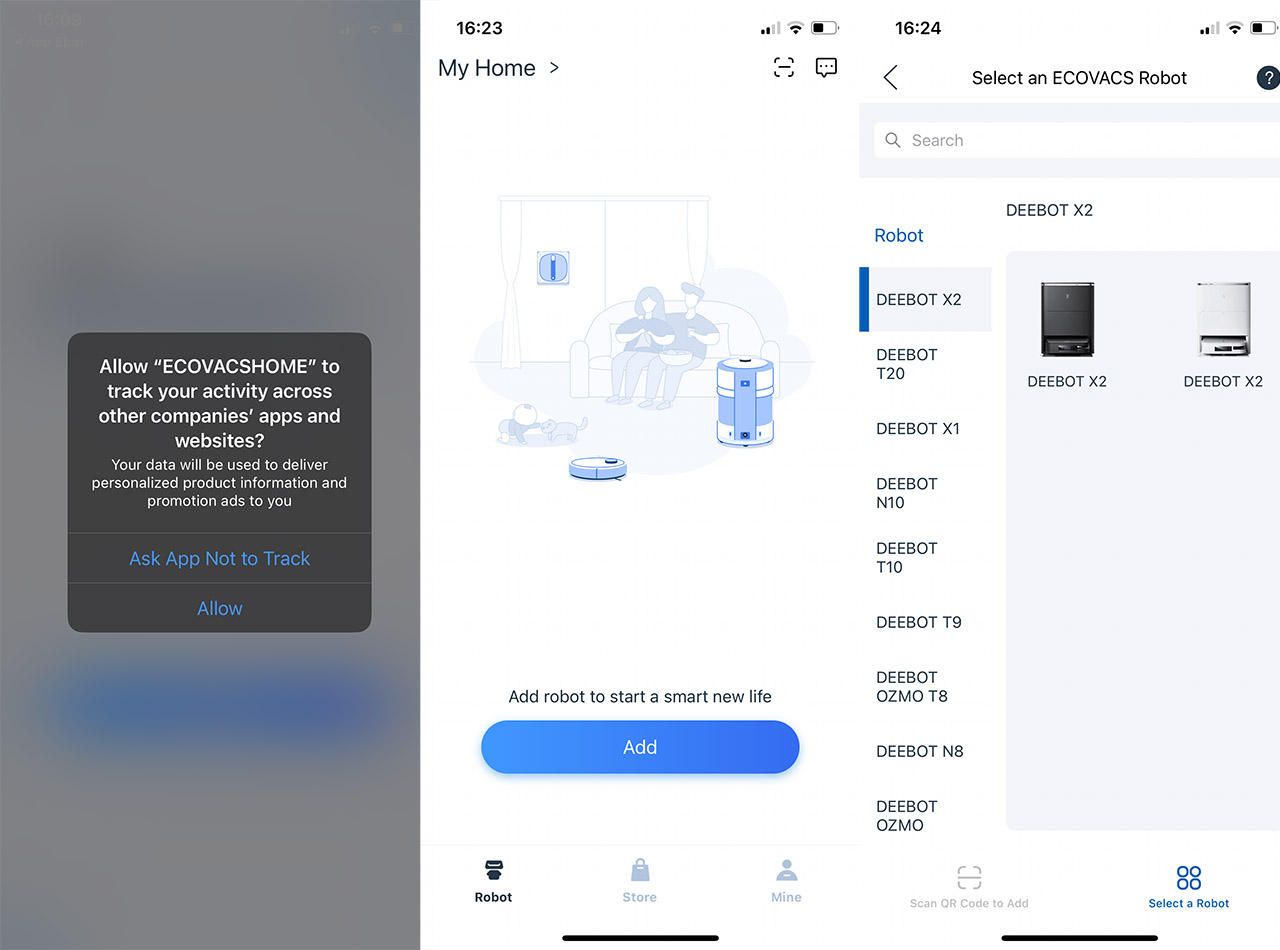
This is not the case with the X2 Omni which functions just fine without needing any of the aforementioned permissions. At the same time, do know that both the T20 Omni and the X2 Omni has a microphone which always listens for the activation phrase. The manufacturer does mention that all data prior and post enabling Yiko will be discarded – some other manufacturer, the big ones, such as Amazon have a very bad track record despite claiming the same, so who knows if that’s true.
Additionally, be aware that the X2 Omni has a front-facing camera which is linked to a proper surveillance system, so take that in account if you’re privacy-conscious.
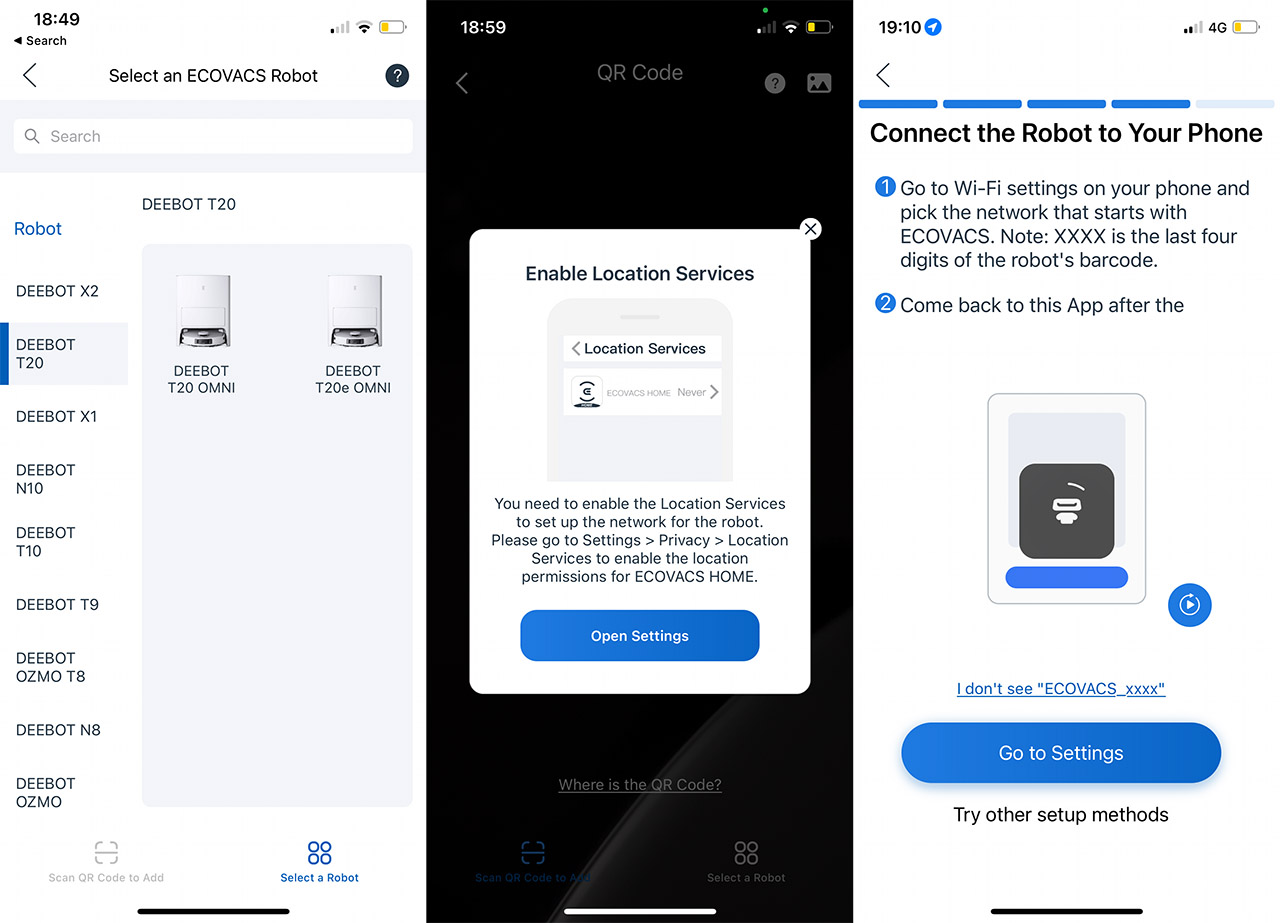
VERDICT: The T20 Omni is by far more demanding during the pairing process, but considering that the X2 Omni has a camera, it’s not really a champion in terms of privacy either. So, in the end, I think that this round will also end in a tie.
The Mobile App Experience
The ECOVACS robot vacuum cleaners use the same app, but, while each device has its set of features, the large majority is actually similar and even identical. For example, the X2 Omni does allow the view of the map in 2D and 3D, same as the T20 Omni, and both allow the addition of furniture. But, in my tests, the X2 Omni was able to detect furniture, while the T20 Omni could not and I could also see the furniture in 2D mode as well with the X2 Omni.
So, the T20 Omni is a bit more limited in this regard, but at the same time, I did experience a bug with the X2 Omni where the furniture was not detected and I could not add any piece to the map – this bug disappeared after I mapped another floor.
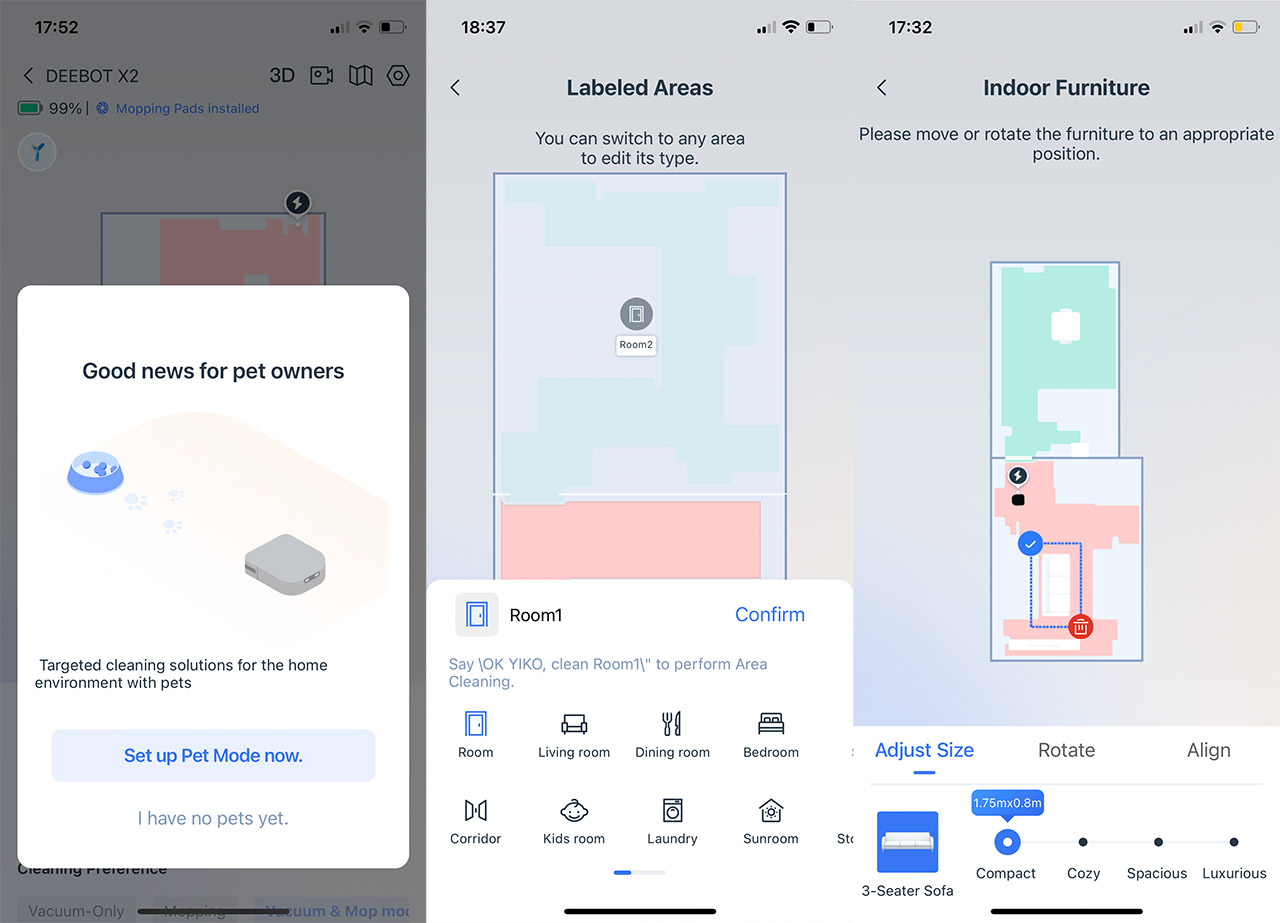
Another similarity between the two robot vacuum cleaners is that you can’t name the rooms yourself, but only use the preset names. Moving forward, we see that each device supports the division of the rooms, as well as the option to merge them and create no-access zones. And you can also create schedules, as well as personalized cleaning runs. An interesting aspect of the T20 Omni was the Housekeeping mode where the robot vacuum cleaner would detect by itself if it needed to ramp up the suction level, as well as better clean areas that are prone to get dirty quicker.
A similar approach can be found on the X2 Omni if you enable the AI, where the robot vacuum cleaner would learn from multiple runs of the room and would get better at cleaning and avoiding objects after every cleaning run. The Yiko voice assistant continues to play an important role on both robot vacuum cleaners, allowing the user to control their behavior using voice commands.
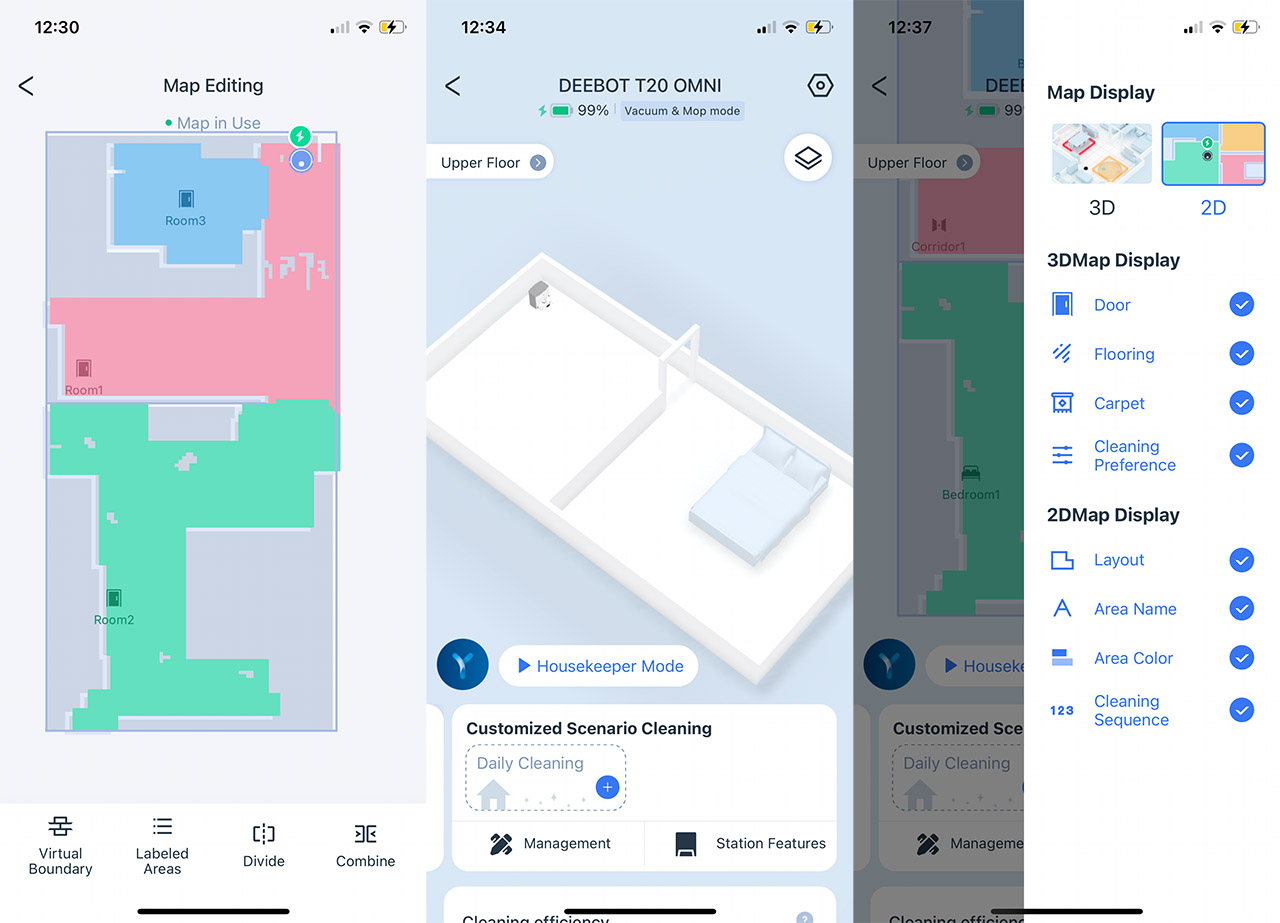
And it works really well due to the well-placed microphones and speakers. Additionally, I did see some control over which functions will be enabled and which won’t. And I also need to mention the huge bug that I experienced with the T20 Omni, where the docking station essentially stopping its functions, and after several app restarts, did I realize that there was a task hanging in the background. A complete device restart would have fixed it, I have no doubt, but it’s a far less benign bug than the map issue with the X2 Omni.
VERDICT: I think that the X2 Omni layout is more refined and the functions are more cleverly added. Plus, there’s the huge bug with the T20 Omni. This is why I think that the X2 Omni wins this round without a doubt.
The Navigation: LiDAR vs AIVI
The ECOVACS DEEBOT T20 Omni uses a combination between full-fledged LiDAR for navigation and what the developers call TrueDetect 3D lasers for object avoidance. The DEEBOT X20 Omni on the other hand uses a combo between a solid-state LiDAR system, a simplified (and slightly less performing) version of the full LiDAR tech, and the AIVI 3D 2.0 camera technology to navigate the rooms and for object identification + avoidance.
The amazing thing is that navigation-wise, I did not notice a significant difference between the two systems. Both robot vacuum cleaners will initially go around the edges of the room / furniture and then they will follow a horizontal line pattern to vacuum and mop the area. Each device will go very near the corners and the edges and neither really got stuck in normal conditions – the X2 Omni will actually go underneath chairs and in very narrow spaces without struggling too much to get out.
The T20 Omni is a bit larger, so it will not fit in the same manner of spaces. The object detection is also incredibly similar and that’s quite the feat because it’s a bit easier for the X2 Omni ‘to actually see’ what’s in front of the camera, while the T20 Omni needs to detect it. And both vacuum cleaners have successfully detected larger objects (slippers), cables and pet poop. This last one is incredibly important because I have seen a strange behavior from other brands where the robot vacuum cleaner would forget that it detected the poop when it had to return and recharge at the base. This way, you would get an unwanted mess. The X2 Omni and the T20 Omni will perform well in this regard.
But there is a difference between them and it happens with very small objects. I have put a 2.5 x 1.5 x 0.4 inches (6.5 x 3.7 x 1.0cm) remote control in front of the X2 Omni and it has avoided it successfully, but this did not happen with the T20 Omni which would eat it up every time. So, while the navigation and the object detection remains stellar in most cases, it will not work that well with very small objects.
The pure-LiDAR system of the T20 Omni will also have a slight advantage during the night, even though I didn’t yet see any problem with the X2 Omni roaming the rooms. And, before I wrap this up, I need to mention the option to view what’s going on in the rooms using the front-facing camera (POV mode) and you can also let it do surveillance rounds as an addition to your home security.
VERDICT: I have to mention that the ECOVACS DEEBOT T20 Omni is absolutely spectacular in terms of navigation and object detection, and the fact that the developers managed to accomplish such a feat with resorting to a camera makes things even more impressive. But, objectively speaking, the X2 Omni is marginally better, so I have to give it this round.
The Performance
The Noise
Both the X2 Omni and the T20 Omni have four levels of suction power and, as you can see from the tables, the former wins since it’s a bit less loud.
| ECOVACS DEEBOT X2 Omni | ECOVACS DEEBOT T20 Omni | |
| Quiet Mode | 40dB | 44dB |
| Standard Mode | 52dB | 58dB |
| Strong Mode | 56dB | 62dB |
| Max+ Mode | 65dB | 67dB |

Mark is a graduate in Computer Science, having gathered valuable experience over the years working in IT as a programmer. Mark is also the main tech writer for MBReviews.com, covering not only his passion, the networking devices, but also other cool electronic gadgets that you may find useful for your every day life.

